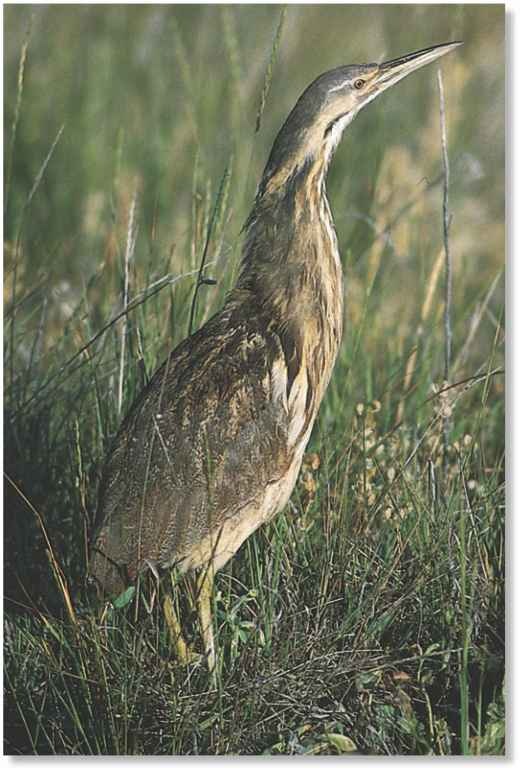ORDER
Ciconiiformes
FAMILY
Ardeidae
GENUS & SPECIES
KEY FEATURES
• Shy and timid, the North American bittern stalks its prey in dense marshes at night
• Brown plumage keeps it well camouflaged in marsh habitat during the day; remains motionless when threatened
• Constructs solitary nests on the ground, unlike other herons, which nest in large colonies in trees
WHERE IN THE WORLD?
Ranges in North and Central America, from south and central Canada southward throughout the U.S. and Mexico, and south to Panama; also found in Cuba and the West Indies
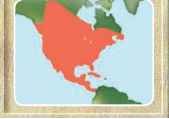
LIFECYCLE
The booming courtship call of the North American bittern is a common sound on warm spring evenings, as the reclusive male tries to attract a mate.
Habitat
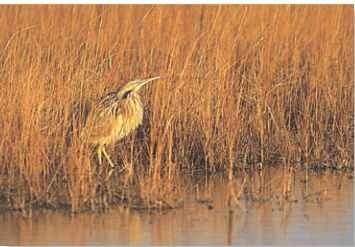
A Walking tall The North American bittern prefers areas with tall vegetation to escape from danger.
The North American bittern is widely distributed throughout North and Central America. It inhabits a variety of habitats, including marshes, wet meadows and bogs with fresh, brackish or saltwater. This bittern lives among tall vegetation, such as cattails, reeds, and bulrushes, relying on its streaked coloration to blend with its surroundings. Unlike other bitterns, it rarely perches in trees and is usually found on the ground. Despite being widely distributed and fairly common, the North American bittern remains out of sight; often, the only sign of its presence is its call.
Conservation
The North American bittern is threatened in some areas of the world. Numbers are declining in the United States, especially in the central states, due to habitat loss. The North American bittern is endangered in Illinois, Indiana and Ohio, and is designated a species of special concern in other states by the USDI (United States Department of the Interior).
Behavior
During the day, the North American bittern roosts among the reeds and rushes of the marsh. When it senses a threat,
it hides by becoming completely still, pointing its bill upward and contracting its body. It blends so well with its surroundings that the intruder usually passes without spotting the bird.
North American bitterns are largely migratory in the northern parts of their range. From September to November the birds migrate south, traveling only at night. They spend the winter months in the southern United States, Mexico, Central America and the West Indies.The birds return in spring.
Where’s the bittern? The bittern’s camouflage is very effective.
Food & feeding
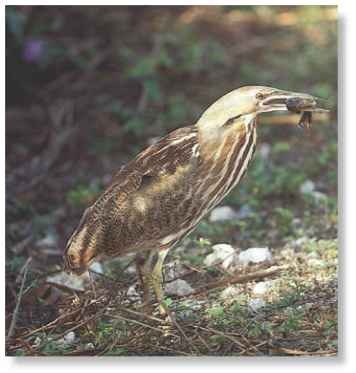
Like most bitterns, the North American bittern is largely nocturnal and ventures out at dusk to forage for food. It typically feeds alone while slowly walking in shallow water, but will occasionally feed by running after its prey. Rather than stabbing food with its sharp, pointed bill, the bittern instead grabs the food before swallowing it whole. Its diet is variable but mainly consists of aquatic prey, including eels, catfish and perch.
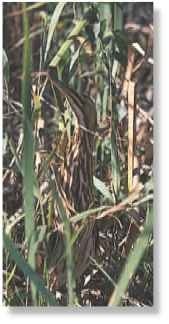
The bittern thrusts its head skyward in its camouflaging posture. Most birds would be left looking at the sky in this position, but the bittern’s eyes are set so low, it can still see straight ahead through the reeds.
The courtship booms of the North American bittern sound like an old pump, inspiring the common name, “thunder pumper.”
SLIPPERY MEAL
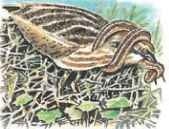
Catch…
With its hooked bill, the bittern pulls an eel from the shallow water. Gripped firmly, the eel tries to curl itself around the bird’s head.
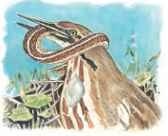
Eat…
As the bittern swallows the eel, the feathers on the bird’s head and neck become soiled from the slimy meal.
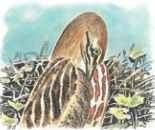
Collect…
After finishing its meal, the bittern collects the powdery down from its breast feathers to clean its soiled plumage.
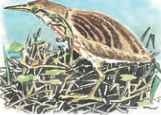
Comb
The bittern then uses the fine teeth of its elongated middle toe as a comb and removes the slime from its plumage.
BREEDING
North American bitterns are well known for their distinct booming calls during the breeding season. Males court females from April to July by calling out in the night. They fill their distended esophagus with air from the lungs and emit a distinct pump-er-lunk several times.The sound can carry over 0.5 mile. Males then perform displays, strutting around females with their pair of white, fanlike ruffs raised over the back.
No pair bonds are formed, and the female performs most of the parental duties. After mating, the female builds a solitary nest on a platform of dead reeds in areas of dense covering. She lays from 2-7 eggs and incubates them alone for about 30 days. The chicks fledge after about 2 weeks.
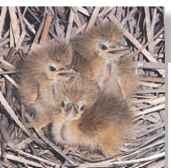
A Growing fast The downy chicks are born helpless, but can fly in a few weeks.
Protection The female protects and guards her young in the nest.
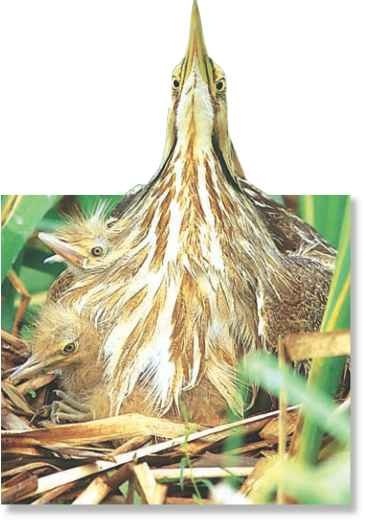
PROFILE
North American Bittern
The North American bittern is a master of disguise, using its streaked plumage and upright pose to blend with its marshland habitat.
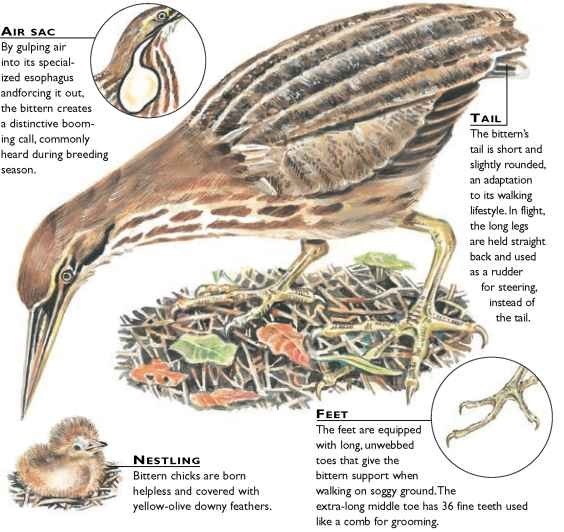
CREATURE COMPARISONS
The South American bittern (Botarus pinnatus) lives in Central and South America from eastern Mexico southward to Brazil. This bittern inhabits freshwater swamps and marshes among stands of tall, dense vegetation and, unlike its North American cousin, is rarely found in brackish or saltwater. Like the North American bittern, the South American bittern feeds at night on fish, eels and other vertebrates. The South American bittern appears to be a year-round resident in its range, compared to the North American bittern, which is largely migratory.
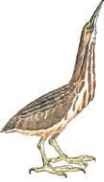
North American bittern
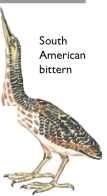
| VITAL STATISTICS | |
| Weight | 1-2 lbs. |
| Length | 24-34″ |
| Wingspan | Up to 50″ |
| Sexual Maturity | Unknown . |
| Breeding Season | April-July |
| Number of Eggs | 2-7; usually 3-5 |
| Incubation Period | 28-29 days |
| Fledging Period | About 2 weeks |
| Breeding Interval | 1 year |
| Typical Diet | Mainly fish, eels, frogs, toads, snakes and insects |
| Lifespan | Unknown |
RELATED SPECIES
• The order Ciconiiformes contains 113 species in 38 genera and includes herons, bitterns, hamerkops, storks, shoebills, ibises and spoonbills. The North American bittern is one of 12 species of bitterns in the heron family, Ardeidae. There are 4 species in the genus Botarus, I including the Eurasian bittern, Botarus stellaris and the Australasian bit- tern, B. poiciloptilus.
